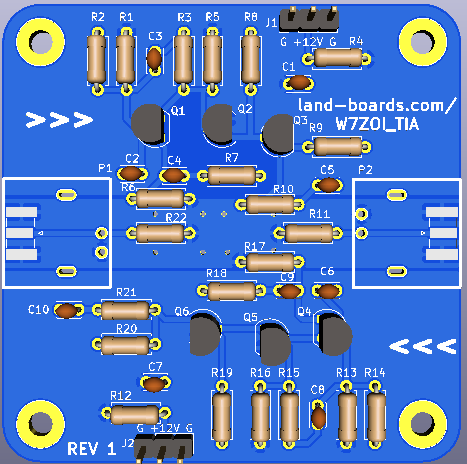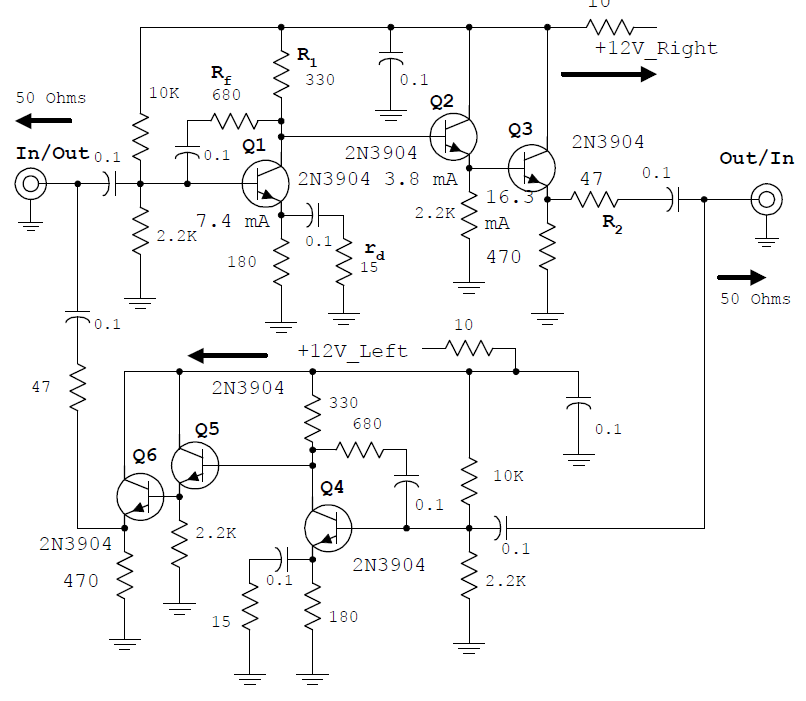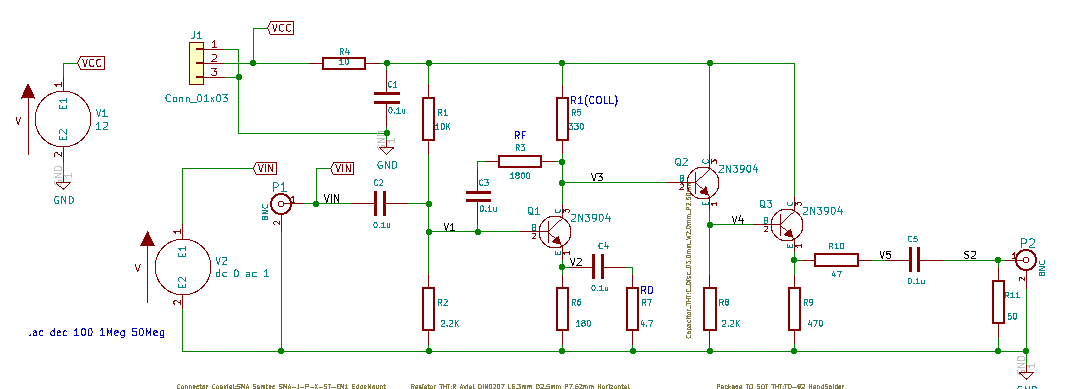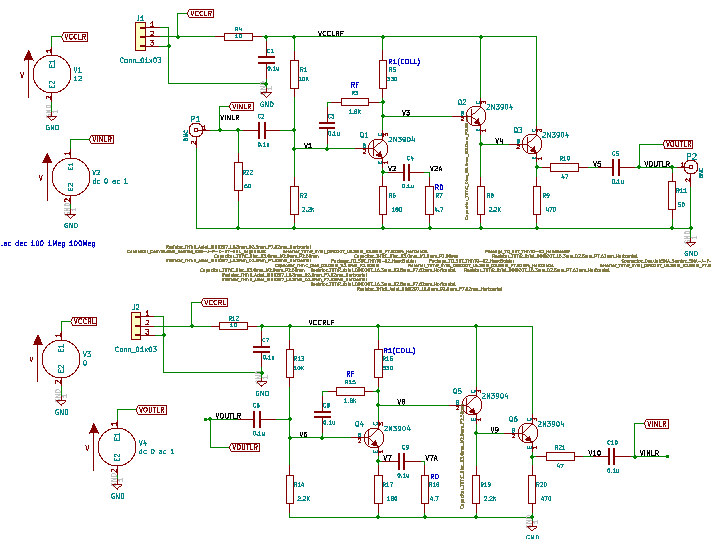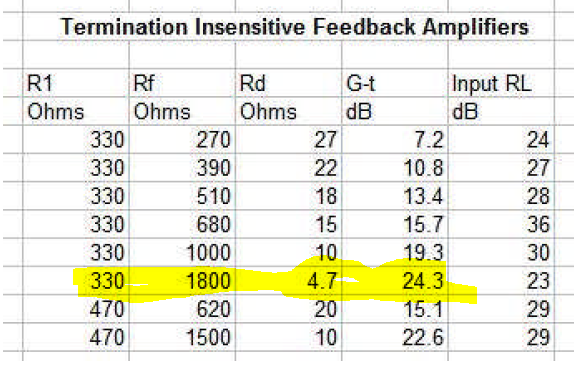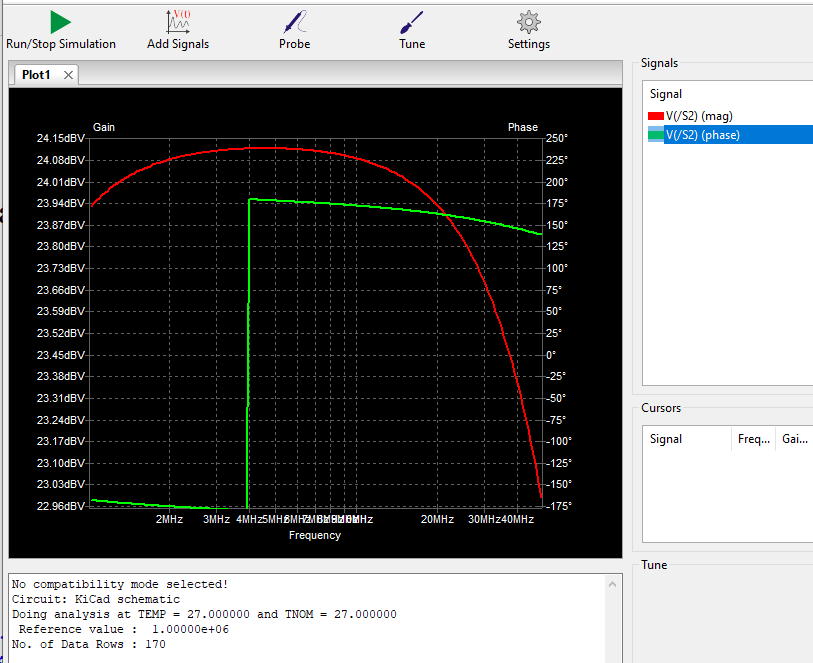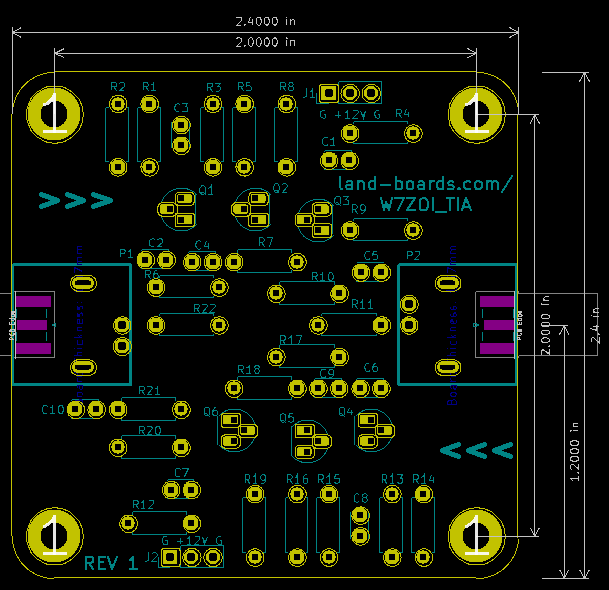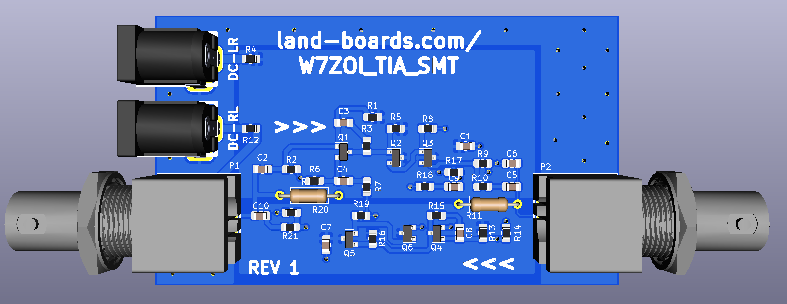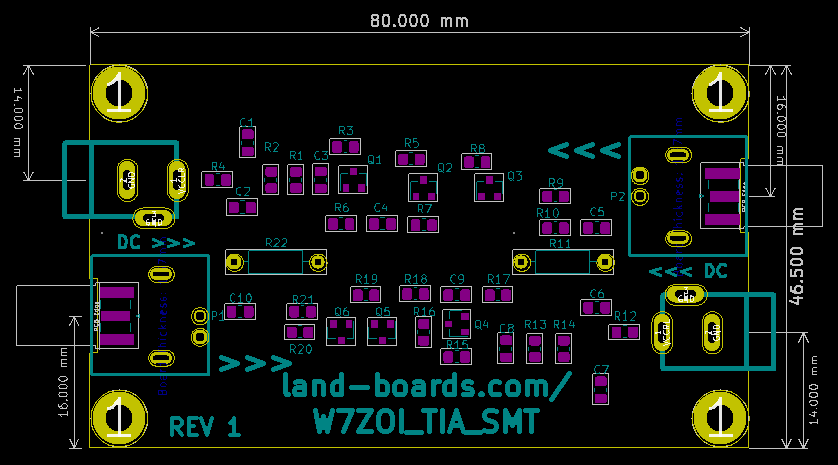|
|
| Line 1: |
Line 1: |
| − | [[File:RF-Amp_P1943-720px.jpg]] | + | [[file:W7ZOI_TIA_3D.png]] |
| | | | |
| − | == RF Amplifier Features == | + | == W7ZOI Design == |
| | | | |
| − | * From [https://zl2ctm.blogspot.com/2020/11/go-qrp-portable-ssb-rig.html Charlie Morris' (ZL2CTM) Go QRP Portable SSB Rig]
| + | Paper - [http://w7zoi.net/bidirectional_matched_amplifier.pdf A Termination Insensitive Amplifier for Bidirectional Transceivers] - W7ZOI (Wes Hayward) design |
| − | ** Charlie references Solid State Design for the Radio Amateur (pp 19-20)
| |
| − | * Single 2N3904 NPN transistor
| |
| − | ** Ft = 300 MHz (Gain Bandwidth Product)
| |
| − | *** Theoretical gain
| |
| − | **** +20 dB at 30 MHz
| |
| − | **** +29.5 dB at 10 MHz
| |
| − | * +22 dB gain @12V, +25dB gain @14V
| |
| − | * Input connectors: SMA or BNC
| |
| − | * +12V nominal power
| |
| − | * 49x49mm card
| |
| − | * 4x 4-40 mounting holes
| |
| | | | |
| − | == RF Amplifier Design ==
| + | * Termination Insensitive - input impedance that does not depend upon the output load |
| | + | * Bi-directional - amplifiers in both directions |
| | + | * 50 ohms in/out |
| | + | * BNC or SMA Connectors |
| | + | * Transformer-less |
| | + | * Power applied to one half at a time - determines signal flow direction |
| | + | * Use |
| | + | ** Between RF/LO mixer (IF output/input) and crystal filter |
| | + | ** Between Crystal Filter and Product Detector / Balanced Modulator |
| | | | |
| − | === Schematic ===
| + | [[FILE:W7ZOI_SCHEMATIC.PNG]] |
| | | | |
| − | [[file:RF_Amp_Schematic-4.PNG]]
| + | == Schematic in KiCAD == |
| | | | |
| − | == LT Spice Simulation ==
| + | * Single channel |
| | + | * With SPICE directives |
| | | | |
| − | * [https://github.com/land-boards/lb-boards/blob/master/HamRadio/RF-Amp/LTSpice/2n3904%20amp.asc LTspice Simulation] - GitHub source file
| + | [[file:W7ZOI_SCHEMATIC_KiCAD.PNG]] |
| − | ** +28.4 dB at 9 MHz
| |
| | | | |
| − | [[File:RF-AMP-LTSPICE_XFMRS.PNG]]
| + | * Both channels |
| | + | * With SPICE directives |
| | | | |
| − | == Charlie Morris Design ==
| + | [[file:W7ZOI_SCHEMATIC_KiCAD-2.PNG]] |
| | | | |
| − | * From Charlie's notes with mods for my use
| + | == NGSPICE Simulation == |
| − | ** [https://zl2ctm.blogspot.com/2020/11/go-qrp-portable-ssb-rig.html Charlie Morris' (ZL2CTM) Go QRP Portable SSB Rig]
| |
| − | ** Charlie describes the design in detail in his video [https://www.youtube.com/watch?v=CHdtoupH2Vg Simple SSB Rig: Part 6 - IF Amplifiers] (Feb 2021)
| |
| − | ** Based on the Class A RF Amplifier in [https://www.amazon.com/Solid-State-Design-Radio-Amateur/dp/0872590402 Solid State Design for the Radio Amateur] pp 19-20
| |
| − | * [https://www.mouser.com/datasheet/2/308/1/2N3903_D-2310199.pdf 2N3904 data sheet]
| |
| − | * [https://www.electronics-tutorials.ws/amplifier/emitter-resistance.html Emitter Resistance] - helpful paper
| |
| | | | |
| − | === Beta DC ===
| + | * NGSPICE run from KiCAD |
| | + | ** [http://ngspice.sourceforge.net/ngspice-eeschema.html Tutorial: ngspice simulation in KiCad/Eeschema] |
| | + | * +24 dB @12V |
| | + | * 2N3904 Alternate Node Sequence (MMBT3903 - SOT23) |
| | + | ** KiCAD order 1 2 3 is the SPICE normal order |
| | + | ** NGSPICE order: 3 1 2 |
| | | | |
| − | * Geometric mean min/max beta at operating current
| + | [[file:W7ZOI_Simulation_KiCAD-3.PNG]] |
| − | ** =sqrt(100*300) = 173
| |
| | | | |
| − | === Beta AC ===
| + | * Closely matches |
| | | | |
| − | * Gain bandwidth product divided by operating frequency
| + | [[file:W7ZOI_Gainz.PNG]] |
| − | ** Assume operating frequency of 9 MHz (IF frequency)
| |
| − | ** = 300/9 = 33.3
| |
| | | | |
| − | === DC Operating Point ===
| + | * Across Band |
| | + | [[file:W7ZOI_Simulation_KiCAD_S2.PNG]] |
| | | | |
| − | * Max HFE RF gain at CE current of 10 mA
| + | == CAD == |
| − | ** If Vce = 6V, this is 60 mW power dissipation
| |
| − | * Assume Ve (voltage across emitter resistor) = 1/10 Vcc = 12V/10 = 1.2V
| |
| − | ** R3 is Re (emitter resistor) = 1.2V/0.01A = 120 ohms
| |
| − | * VCE = 0.7V (typical from data sheet)
| |
| − | * V(emitter) at 10% of Vcc rule of thumb = 1.2V
| |
| − | * V(base) = V(emitter) + VCE = 1.9V
| |
| − | * Base current is collector current divided by Beta DC
| |
| − | ** Biasing resistors = 10x current needed by base current
| |
| − | ** 10 mA in C-E, beta DC less = 10 mA/173 = 58 uA
| |
| − | ** 10x the current in the biasing resistors = 580 uA (calculated)
| |
| − | * R2 is 1.9V at 580 uA = 3.29K use 3.3K
| |
| − | * R1 sources current to R2 and transistor base
| |
| − | ** Voltage = Vcc (12V) - 1.9V = 10.1V
| |
| − | ** Current = 577 uA + 58 uA = 635 uA
| |
| − | ** R1 = 10.1 / .635 mA = 15.9K, use 15K
| |
| | | | |
| − | ==== Measured DC operating point ====
| + | [[FILE:W7ZOI_CAD.PNG]] |
| | | | |
| − | * Measured with no input
| + | == SMT Build == |
| − | * Vcc = 11.96V
| |
| − | * Current draw = 12 mA
| |
| − | ** Expected 11 mA - close enough
| |
| − | * +BUFF = 11.84V
| |
| − | ** 0.12V which is 12 mA through R4 10 ohms - expected
| |
| − | * V emitter = 1.41V
| |
| − | ** 12 mA through 120 ohm = 1.44V - close
| |
| − | * V on input divider = 2.06V
| |
| − | ** Vbase + 0.7V - close
| |
| | | | |
| − | === Input resistance ===
| + | [[FILE:W7ZOI_TIA_SMD_3D.png]] |
| | | | |
| − | * Xc for 0.1uF cap from emitter to ground
| + | [[FILE:W7ZOI_TIA_SMT_CAD.PNG]] |
| − | ** C=0.1uF
| |
| − | ** F=10MHz
| |
| − | ** 1/2*pi*F*C = 0.16 ohms
| |
| − | * Parallel resistors R1, R2 paralleled with transistor input impedance
| |
| − | ** R1=15K, R2=3.3K
| |
| − | ** Transistor resistance = Beta AC (33.3) times re
| |
| − | *** re = 26 / Ie (10 mA in mA) = 26/10 = 2.6
| |
| − | *** SSDRA uses 25 as constant - close enough
| |
| − | *** Beta AC * re = 33.3*2.6 = 83.3 ohms - predominates
| |
| − | ** All in parallel are 80.8 ohms
| |
| | | | |
| − | === Input/Output Transformers === | + | == Videos == |
| | | | |
| − | * [http://toroids.info/FT37-43.php FT37-43 Toroid]
| + | <video type="youtube">JjcxEYk9atg</video> |
| | | | |
| − | [[file:FT37-43_10_Turns.PNG]]
| + | <video type="youtube">T8lq8Qtjqe0</video> |
| − | | |
| − | ==== Tracks ====
| |
| − | | |
| − | [[file:RF-Amp-tracks.PNG]]
| |
| − | | |
| − | ==== Input Transformer ====
| |
| − | | |
| − | * Input Transformer (T1 on Charlie's - T2 on this board)
| |
| − | * Need to calculate turns ratio
| |
| − | * 50:80.8 Ohms
| |
| − | * n = sqrt(Zout/Zin)sqrt(80.8/50) = 1.27 turns ratio
| |
| − | * Turns choices
| |
| − | * Minimum number of turns
| |
| − | * Rule of thumb - want Xl (coil impedance smallest value) to be least 4-5X the load
| |
| − | ** Load = 80.8 ohms
| |
| − | ** 5 * 80.8 ohms = 404.2 ohms minimum
| |
| − | *** More turns = larger capacitance and drops bandwidth
| |
| − | ** Toroid is FT37-43
| |
| − | ** From [http://toroids.info/FT37-43.php Toroid page]
| |
| − | *** Xl = 404.4 at 9 MHz is 4.5 turns, round up to 5
| |
| − | ** Try nearest integer numbers turns ratios
| |
| − | *** 5:6 = 6% error
| |
| − | *** 6:8 = -4.6%
| |
| − | *** 7:9 = -1.1% << good choice
| |
| − | *** 8:10 = +1.7%
| |
| − | *** 9:11 = +4.0%
| |
| − | *** 10:13 = -2.19%
| |
| − | * Use 7:9 turns ratio for optimal input transformer
| |
| − | | |
| − | [[file:RF-Amp-T2.PNG]]
| |
| − | | |
| − | ==== Output Transformer ====
| |
| − | | |
| − | * Output transformer (T2 on Charlie's - T1 on this board)
| |
| − | * T2 - different than Charlie's design since my Crystal filters are all 50 ohms in/out
| |
| − | * SSDRA suggest presenting 200 ohm load to the collector
| |
| − | ** Can't find reference in SSDRA
| |
| − | ** Reflecting back 50 ohms load to 200 ohm collector...
| |
| − | * 200:50 ohms
| |
| − | * n = sqrt(200/50) = 2.0:1 turns ratio
| |
| − | * 10:5 turns
| |
| − | ** 10 turns primary (on transistor collector)
| |
| − | *** 10 turns = 35 uH
| |
| − | ** 5 turns secondary (towards output)
| |
| − | *** 5 turns = 8.75 uH
| |
| − | ** 15 turns = 9.5 in
| |
| − | | |
| − | [[file:RF-Amp-T1.PNG]]
| |
| − | | |
| − | === Charlie's Notes ===
| |
| − | | |
| − | [[FILE:IF Amp_0046A.jpg]]
| |
| − | | |
| − | [[FILE:IF Amp_0046B.jpg]]
| |
| − | | |
| − | [[FILE:IF Amp_0046C.jpg]]
| |
| − | | |
| − | [[FILE:IF Amp_0047A.jpg]]
| |
| − | | |
| − | [[FILE:IF Amp_0047B.jpg]]
| |
| − | | |
| − | [[FILE:IF Amp_0047C.jpg]]
| |
| − | | |
| − | == NanoVNA Measurements ==
| |
| − | | |
| − | * '''Goal''': Measure RF-Amp performance using a [[NanoVNA]] running [https://nanovna.com/?page_id=90 NanoSaver software on PC]
| |
| − | * S21 (gain) needs to be measured with a [[RF_Attenuators#40_dB_Attenuator|40 dB attenuator]] on input to RF-Amp to avoid compression on the output
| |
| − | * S11 (reflection) input impedance can't be measured with input [[RF_Attenuators#40_dB_Attenuator|40 dB attenuator]] because S11 just ends up measuring the attenuator
| |
| − | ** Output should be terminated to 50 ohms for S11 measurement
| |
| − | * DC current = 12 mA
| |
| − | | |
| − | === Measure S21 ===
| |
| − | | |
| − | * Put [[RF_Attenuators#40_dB_Attenuator|40 dB attenuator]] on RF-Amp input, measure S21 at output
| |
| − | ** [[NanoVNA]] provides 50 ohm load to RF-Amp to properly terminate output
| |
| − | * Measure S21 with 9:11 input transformer
| |
| − | ** S21 @ 100 KHz = -8 dB dB
| |
| − | ** S21 @ 1.45 MHz = 35.4 dB (peak gain)
| |
| − | ** S21 @ 9.1 MHz = 24.3 dB
| |
| − | ** S21 @ 16 MHz = 20.1 dB
| |
| − | ** S21 @ 30 MHz = 12.7 dB
| |
| − | * Peak gain justifies use of 40 dB attenuator to protect [[NanoVNA]]
| |
| − | | |
| − | [[file:RF-Amp_S21_40dBAttenInput_1-30MHz.png]]
| |
| − | | |
| − | ==== LTspice vs NanoVNA ====
| |
| − | | |
| − | * LTspice simulation was pretty similar to [[NanoVNA]] results
| |
| − | ** -10 dB at 100 KHz
| |
| − | ** +32 dB at peak
| |
| − | ** Lower output at higher frequencies
| |
| − | | |
| − | [[file:RF-Amp_S21_LTspice-vs-NanoVNA_1-30MHz.png]]
| |
| − | | |
| − | === Measure Input Compression ===
| |
| − | | |
| − | * Is there compression if the [[NanoVNA]] drives the input directly?
| |
| − | ** Test by driving directly from NanoVNA set to CW = 9 MHz
| |
| − | ** Measured output with scope - not clipped at 9 MHz
| |
| − | *** Approx. 1Vpp input = +22.1 dBm gain which matches the S21 with the attenuator on the input
| |
| − | *** Vpp = 12.4V with 50 Ohm load resistor
| |
| − | ** Starts clipping at 7 Mhz and down
| |
| − | * Therefore, can measure input impedance at 9 MHz
| |
| − | * Other evidence of compression
| |
| − | ** Compare S21 gain with no input attenuator, put external [[RF Attenuators|40 dB RF Attenuators]] on output of RF-Amp to protect [[NanoVNA]] input
| |
| − | ** S21 shows lower gain in lower frequencies so clipping/compression is happening
| |
| − | ** Was: 35 dB at 1.4 MHz
| |
| − | ** Is: 23.1 dB at 1.5 MHz
| |
| − | * Due to compression can't accurately measure lower frequencies with attenuator at output
| |
| − | * Compression below 7 MHz matches what was on scope
| |
| − | | |
| − | [[file:RF-Amp_S21_40dBAttenOutput_1-30MHz.png]]
| |
| − | | |
| − | === Measure Input Impedance ===
| |
| − | | |
| − | * Shows VSWR at 14.4 MHz = 1.56:1
| |
| − | * At 9 MHz
| |
| − | ** VSWR = 1.7:1
| |
| − | ** Impedance = 81-j10
| |
| − | | |
| − | [[file:RF-Amp_AttenOutput_VSWR_2021_1-30MHz.png]]
| |
| − | | |
| − | === Change Input Transformer turns ratio ===
| |
| − | | |
| − | * Above had 9:11 turns ratio
| |
| − | * Change to 7:9 turns ratio
| |
| − | * Slightly better gain at higher frequencies
| |
| − | * Was: S21 @ 30 MHz = 12.7 dB
| |
| − | * After: S21 @ 30 MHz = 15.3 dB
| |
| − | * Small additional gain at 8 MHz
| |
| − | ** Was: S21 @ 9.1 MHz = 24.3 dB
| |
| − | ** After: S21 @ 9.1 MHz = 24.8 dB
| |
| − | | |
| − | [[file:RF-Amp_S21_40dBAttenInput_Turns7to9_1-30MHz.png]]
| |
| − | | |
| − | * New turns improved the input VSWR slightly
| |
| − | * Was: At 9 MHz, VSWR = 1.7:1, Impedance = 81-j10
| |
| − | * After: At 9 MHz, VSWR = 1.6:1, Impedance = 76.7-j12
| |
| − | | |
| − | [[file:RF-Amp_vswr_40dBAttenInput_Turns7to9_1-30MHz.png]]
| |
| − | | |
| − | ==== Tune input transformer====
| |
| − | | |
| − | * Isolate output by replacing output transformer with 200 resistor
| |
| − | * Add one more output winding to input transformer T2 (7:10)
| |
| − | * VSWR nearly 1.04:1 at 11.1 MHz
| |
| − | * -19 dB return loss at 9 MHz VSWR = 1.249:1
| |
| − | | |
| − | [[file:RF-Amp_VSWR_1-30MHz_7to10Turns.png]]
| |
| − | | |
| − | * With output transformer
| |
| − | * Slightly better with 1 extra winding
| |
| − | | |
| − | [[file:RF-Amp_VSWR_1-30MHz_7to10Turns-2.png]]
| |
| − | | |
| − | == Video ==
| |
| − | | |
| − | <video type="youtube">CHdtoupH2Vg</video>
| |
| − | | |
| − | <video type="youtube">YJTsWV2kzFY</video>
| |
| − | | |
| − | <video type="youtube">xPFzFhM0ojE</video> | |
| | | | |
| | == Assembly Sheet == | | == Assembly Sheet == |
| | | | |
| − | * [[RF Amplifier Assembly Sheet]] | + | * [[W7ZOI TIA Assembly Sheet - Rev 1]] |
